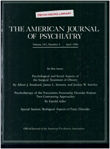Differences between anhedonic and normally hedonic depressive states
Abstract
In this study of 101 patients who met DSM-III criteria for major depression, those with extreme anhedonia (N = 23) were younger, more depressed, and less neurotic than the patients with a normal-range capacity for pleasurable experiences (N = 78). The anhedonic depressed patients recovered more rapidly; at discharge they consequently had levels of symptom severity equal to those of the hedonic patients, yet they remained significantly more anhedonic. The anhedonic patients exhibited loss of pleasure in appetite, sex, social contacts, and work, which suggests a global dulling of the capacity for pleasure.
Access content
To read the fulltext, please use one of the options below to sign in or purchase access.- Personal login
- Institutional Login
- Sign in via OpenAthens
- Register for access
-
Please login/register if you wish to pair your device and check access availability.
Not a subscriber?
PsychiatryOnline subscription options offer access to the DSM-5 library, books, journals, CME, and patient resources. This all-in-one virtual library provides psychiatrists and mental health professionals with key resources for diagnosis, treatment, research, and professional development.
Need more help? PsychiatryOnline Customer Service may be reached by emailing [email protected] or by calling 800-368-5777 (in the U.S.) or 703-907-7322 (outside the U.S.).



